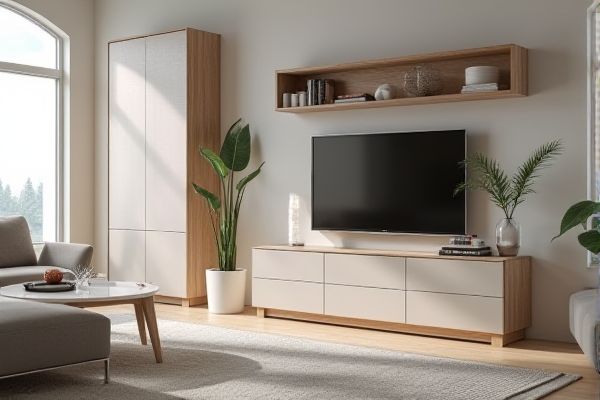
Freestanding cabinets offer versatile placement and mobility, while wall-mounted cabinets save floor space and create a sleek, modern look. Discover which option best suits your storage needs and aesthetic preferences by reading the rest of the article.
Table of Comparison
| Feature | Freestanding Cabinet | Wall-Mounted Cabinet |
|---|---|---|
| Installation | No wall mounting needed; easy to relocate | Requires secure wall mounting; fixed position |
| Space Efficiency | Occupies floor space | Frees up floor space; ideal for small rooms |
| Weight Capacity | Supports heavier items; more stable | Limited weight capacity; dependent on wall strength |
| Design Flexibility | Variety of sizes and styles available | Usually slimmer profiles; modern look |
| Maintenance | Easy access for cleaning and repairs | Harder to clean behind and underneath |
| Common Uses | Living rooms, bedrooms, offices | Kitchens, bathrooms, compact spaces |
| Cost | Generally lower installation costs | Higher installation cost due to mounting hardware |
Overview of Freestanding and Wall-Mounted Cabinets
Freestanding cabinets offer versatile storage solutions with easy mobility and require no wall installation, making them ideal for flexible room arrangements. Wall-mounted cabinets optimize space by elevating storage off the floor, perfect for small rooms or areas needing streamlined organization. Both cabinet types vary in materials, sizes, and design styles, catering to different aesthetic preferences and functional needs.
Design Differences: Freestanding vs Wall-Mounted Cabinets
Freestanding cabinets feature a base that rests directly on the floor, offering mobility and easier installation, while wall-mounted cabinets are fixed to walls, maximizing floor space and creating a streamlined look. Design-wise, freestanding cabinets tend to be bulkier with more structural support to bear their own weight, whereas wall-mounted cabinets are typically lighter and require secure wall anchors for stability. Both styles offer distinct aesthetic and functional advantages depending on spatial needs and interior design preferences.
Space Utilization and Layout Considerations
Freestanding cabinets offer flexible placement options, allowing you to easily reconfigure your space or move the storage as needed, which is ideal for rooms with evolving layouts. Wall-mounted cabinets maximize vertical space by keeping floors clear, making them perfect for small areas or rooms where floor space is limited. Considering your room's size and function will help determine whether the mobility of a freestanding cabinet or the space-saving design of a wall-mounted cabinet better optimizes your layout.
Installation Process: Which Is Easier?
Freestanding cabinets require minimal installation, often just placement and leveling, making them a straightforward option for most users. Wall-mounted cabinets demand precise measurements, secure wall anchors, and sometimes professional installation to ensure safety and stability. Your choice depends on your comfort with tools and the time you can dedicate to the setup process.
Accessibility and Convenience Factors
Freestanding cabinets offer greater accessibility by allowing you to move and reposition them easily, providing flexible storage solutions tailored to changing needs. Wall-mounted cabinets maximize convenience by freeing up floor space and keeping frequently used items within easy reach, ideal for smaller rooms or areas requiring efficient organization. Your choice should consider how often you need to access stored items and the spatial layout of your environment to optimize functionality.
Storage Capacity Comparison
Freestanding cabinets typically offer greater storage capacity due to their larger size and multiple shelves, making them ideal for storing bulky items or extensive collections. Wall-mounted cabinets, while space-saving and perfect for small or narrow areas, provide limited storage volume and are best suited for lighter or frequently accessed items. Choosing between the two depends on the balance between maximizing storage capacity and optimizing room layout.
Durability and Maintenance Needs
Freestanding cabinets typically offer greater durability due to their robust construction and the ability to withstand floor-level impacts, making them less prone to damage over time. Wall-mounted cabinets require secure installation and regular checks to ensure the mounting hardware remains intact, which may increase maintenance needs especially in humid environments. Your choice should consider how much upkeep you are willing to perform and the level of durability needed for your space.
Aesthetic Appeal and Style Options
Freestanding cabinets offer a versatile aesthetic appeal with a wide range of styles, finishes, and sizes that can be easily moved and adapted to different interior designs. Wall-mounted cabinets provide a sleek, modern look with clean lines and the ability to maximize floor space, enhancing minimalist or contemporary decor. Both options allow customization but differ in impact, where freestanding cabinets create a more traditional or eclectic vibe, while wall-mounted units emphasize streamlined and space-saving aesthetics.
Budget and Cost Analysis
Freestanding cabinets typically have a lower initial cost due to simpler installation requirements and standard manufacturing processes, making them a budget-friendly option for homeowners. Wall-mounted cabinets often involve higher expenses not only for the unit itself but also for professional installation, wall reinforcement, and possible customization to fit specific spaces. Considering long-term value, freestanding cabinets can be easily relocated without incurring additional costs, whereas wall-mounted installations may require costly repairs or adjustments if moved.
Choosing the Right Cabinet for Your Space
Freestanding cabinets offer flexibility and mobility, making them ideal for versatile spaces needing frequent reconfiguration or additional storage without wall attachment. Wall-mounted cabinets maximize floor space and provide a sleek, modern look suitable for small rooms or kitchens where keeping the area open and accessible is essential. Assess the room size, storage needs, and installation feasibility to determine whether a freestanding or wall-mounted cabinet best enhances your space's functionality and design.
 homyna.com
homyna.com